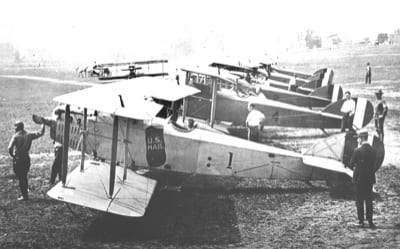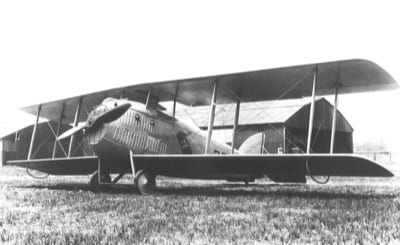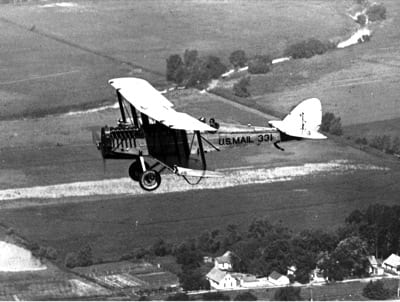
A 1961 British book on the development of air transportation includes a chart on early scheduled air services, which includes the operations of the U.S. Air Mail Service from 1918 till 1927. It may seem unusual to see the Air Mail Service listed here, but as it operated more than 200 aircraft, you realize it was probably the largest civil operator of aircraft in the world at the time.
Air mail service in the United States began with a series of experiments and demonstrations. The first official air mail delivery in the United States was conducted during an air meet on Long Island, N.Y., in September 1911 when Earle Ovington, with his “Queen” monoplane, was appointed an air mail carrier. He covered a set route between a temporary post office established at the flying field and the post office at Mineola, N.Y. During the air meet, 32,415 post cards, 3,993 letters and 1,062 circulars were carried.
Several similar experiments were made during the remainder of 1911 and 1912. Mail was carried on short exhibition and experimental flights by aerial carriers sworn in by the Post Office. Such services were temporary and done without expense to the Post Office. These experimental flights were continued from year to year without any financial support from Congress.
In 1918 the Post Office established its Air Mail Service and, with funding from its “power boat” budget, established the first scheduled air mail route on May 15. The first route was between New York City and Washington, D.C., with a stop at Philadelphia, approximately 218 miles. It provided one round trip daily, except Sunday.
At first Army Air Service planes, personnel and pilots carried out the flying operations in Curtiss JN-4H biplanes powered by 150-hp Hispano Suiza motors. The front cockpit of the Jenny was lined with plywood and was able to carry 150 pounds of mail. The average time for a trip from New York to Washington, D.C., was two hours and 50 minutes. At the end of the first month of operations, the Post Office published a press release noting that 10,800 pounds of mail had been flown over 1,000 miles at an average speed of 70 mph.
In June 1918, Congress appropriated $100,000 for the route between Washington and New York and in August the Post Office took over that route.
At that same time the Air Mail Service took delivery of the first aircraft designed expressly for carrying the mail. This was a batch of six Standard Aircraft JR-1Bs powered by 150-hp Hispano Suiza motors able to cruise at 100 miles an hour and carry 170 pounds of mail. Also obtained at this time were six Curtiss R-4LMs with Liberty engines and six of the Curtiss JN-4Hs. The service was so cost effective that the price of an air mail stamp was reduced from 24 cents to 16 cents.

Other types of aircraft were later obtained, including: Curtiss HA, with Liberty-12 engines; Twin DeHavillands with two six-cylinder Hall Scott engines; Martin mail planes, with two Liberty V-12s; and Junker JL-6 with 200-hp BMW engines. The Air Mail Service also started receiving war surplus, 400-hp Liberty-powered DeHavilland DH-4s from the Army.
In 1919 the Post Office asked for bids to modify the DH-4s to better meet air mail requirements. In some cases new steel tube fuselages were constructed to replace the plywood structure of the original. Boeing was among the companies performing that work. New wing designs were also tried by Sperry, Loening and Bellanca.
This program was discontinued in 1921 when the Air Mail Service adopted the DeHavilland with the Liberty-12 engine as standard equipment. At the same time, the Post Office started doing its own modifications on the DeHavillands, disposing of all other types.

By 1924 the Air Mail Service was flying mail from coast to coast and officials decided that a new and more reliable aircraft was needed to replace the modified DH-4s which it had operated since 1919. This was partly because of the age and service history of the aircraft, as the service was losing six a month, reporting 101 aircraft in crashes by December 1921.
Another factor was that the newly instituted night service required adding 225 pounds of equipment, such as wing tip lights, running lights and a parachute flair system, which reduced the amount of mail that could be carried.
On April 7, 1924, the Post Office invited aircraft manufacturers to submit proposals and quote prices for a new type of mail plane to be built around the 400-hp Liberty engine.
Specifications included a cruising speed of 95 mph, a landing speed of 50 mph and a service ceiling of 15,000 feet. Cargo space was to be at least 50 cubic feet and carry a payload of not less than 1,000 pounds of mail. The planes were also to hold enough fuel for a range of 450 miles. The Post Office was to furnish the engines, while all other material was to be furnished by the manufacturer.
The new planes began flying in spring 1925 with the Aerial Mercury and the Curtiss Carrier Pigeon the first ones. In the fall the Post Office took delivery of the first Douglas Mailplane and the Boeing Model 40. The Douglas was the most successful of the designs, with the Post Office ordering 50.
The Curtiss, Douglas and later versions of the Boeing Model 40 would go on to become important elements in the new companies that were contracted by the Post Office to carry the mail under the Air Mail Act of 1925. This act mandated the Postmaster General to contract for domestic airmail service with commercial air carriers.
The Post Office relinquished operations between Chicago and San Francisco at midnight of June 30, 1927, and between New York and Chicago on Aug. 31, 1927, ending an era that had seen the Post Office as the operator of the world’s largest commercial aircraft fleet.
Dennis Parks is Curator Emeritus of Seattle’s Museum of Flight. He can be reached at [email protected].
